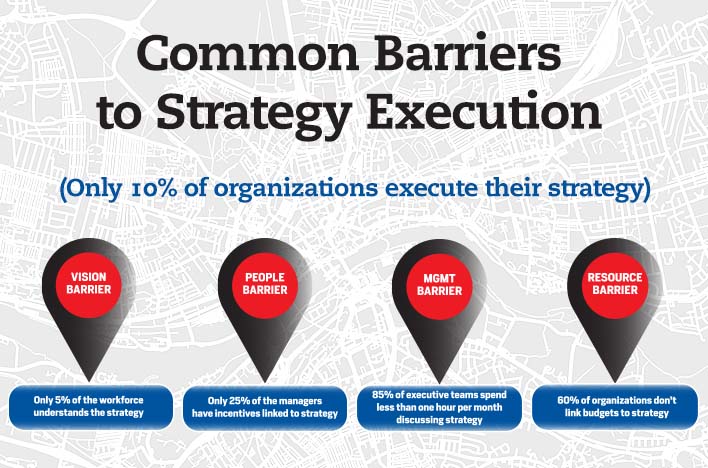Strategic planning is an organization’s process of defining its strategy or direction, and making decisions on allocating its resources to pursue this strategy.
Benefits of strategic planning include:
- Improving employee, customer and supplier relations
- Reducing overall risk
- Preparing for profitable growth
- Maximizing long-term value
- Enhancing access to capital
- Increasing transferrable value
In a recent Small Business Pulse survey, 75 percent of the owners surveyed believe that a written strategic plan causes their business to perform at a higher level in sales and profits.
In addition, if your business is one of the 250,000 businesses that baby boomers will transition by 2030, the transferrable value of your business will be greatly enhanced by having a strategic plan in place.
So one might ask:
- Why doesn’t our company have a strategic plan?
- Why can’t we execute the strategic plan we have developed?
Well, many companies think the planning process in general is superfluous; as long as the business is generating revenue and has money in the bank, it is doing fine.
However, “the biggest issue in strategic planning is not the formulation, but rather the implementation,” according to the Association of Strategic Planning, the leading global nonprofit professional association dedicated to advancing thought and practice in strategy development and deployment for business, nonprofit and government organizations.
How do you ensure the development and execution of your company’s strategic plan? Follow the steps below.
DISCOVER
Where is the business today?
- Assess all areas of the company that impact every business regardless of size or industry: financial, planning, leadership, people, sales, marketing, operations and legal.
- Complete a SWOT analysis (strengths, weaknesses, and opportunities and threats) to define the internal and external factors that may impact the company’s future performance.
DEFINE
This is the big picture; typically three to five years in the future.
Mission // An external statement as to why the company exists: business, customers and competitive advantage.
Vision // An internal, inspirational statement defining what the company will look like in the future: beliefs, values and behavior.
Objectives // Identify three top-level objectives for the company, of which one should be EBITDA (i.e. sales—expenses before interest, taxes, depreciation or amortization)
Strategies // Identify three to five strategies that are based on the company’s strengths and are focused on achieving the company’s mission.
FOCUS
Develop the company’s strategic plan utilizing the discovery information to identify gaps and opportunities needed to achieve its defined mission, vision, top-level objectives and strategies.
- Identify solutions in each of the key areas (financial, planning, leadership, people, sales, marketing, operations and legal) and ensure alignment of the departmental goals and compensation programs with these solutions.
- Determine objectives for the next one to two years
- Determine tactics and action items for each 90-day period
- Every action should tie specifically to one of the three company objectives
IMPLEMENT
Communicate, monitor and review
- Formalize future projections, including the costs associated with achieving the objectives.
- Develop and monitor key performance indicators that align with and support the strategic plan.
- Communicate frequently with all levels of the company, ensuring they understand their part in the company’s success.
- Review progress each quarter.
- Annually reset based on actual performance.
Taking the time to clearly articulate the purpose and direction of your business will, quite simply, help your business achieve success at a much more rapid pace. It will allow you to take the focus off of the day-to-day and project a picture of the future, including the steps needed to get there.


